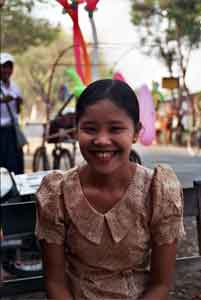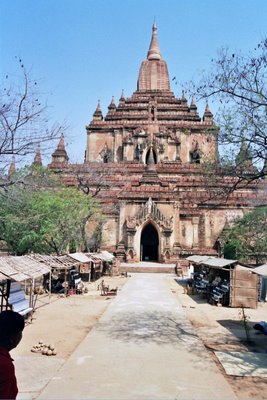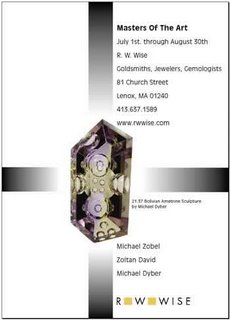
By Richard W. Wise, G.G.
©2006
Day Two:
After a good night’s sleep we are up and on the road early. The morning is cool, the air sweet like early
In one small town, Lwin pulls over. There is a wedding in progress and he stops for me to take few shots. I am immediately accosted by one of the guests who insists that I come in and take a picture of the bride and groom. The music stops, I am shown a seat. Tea, cakes and a pack of cigarettes appear on the table before me. I am embarrassed, upstaging the young couple on this their most important day. They seem bemused and not at all pleased. They are young, perhaps fourteen, and sit solemnly on a small raised stage in the front of the hall, he in a white suit, she in a wedding dress. So I smile, take a few photographs, bob my head up and down, mouth inanities, thank the guests and back the hell out of there.
The landscape becomes increasingly arid as we move along the second leg of our journey. The tarmac ends and we are on a narrow sandy dirt road. It looks like drought.
The fields are dusty and flat and the clipped dry grass rolls out toward the horizon in all directions. The trees are devoid of leaves with knarled brown fingers clutching at the sky. Even the peasants working their fields have changed their color from dark copper to light mocha brown. They are preparing their fields but planting must wait for the rainy season that is nearly six months away. We stop for lunch in a restaurant in a small rural town called Kwajo.
Our second night finds us camped out in a small hotel on the banks of the
Much of our second day’s travel his been within site of the river. We can see mist shrouded mountains lining the far bank. The golden dome of a pagoda sparkles in the afternoon sun. Barges and small freighters ply their trade along the river. We have our dinner and breakfast in a garden setting along the riverbank with the welcoming limbs of a giant Acacia spread in a canopy above us.
On the way into Bagan we visit our first Pagoda. This one, built in 1183 is, like most, a square layered wedding cake built of red brick with plastered interior walls. The bricks are artfully joined, a testament to the craftsmen who built them. The temple has several giant Buddha statues. The vaulted passages that run the circumference are long and dark and the walls are frescoed with paintings of dragons, mythical monsters and devotees in attitudes of meditation. Arched windows have been placed at all points of the compass but they do little to mitigate the baking heat of the late afternoon. To my guide’s disgust, many of the frescoes have been inexpertly restored. This is the work of the generals “who are not educated men” and insist upon reconstructing much of the ruins which Lwin rightly believes should be left alone.
late afternoon. To my guide’s disgust, many of the frescoes have been inexpertly restored. This is the work of the generals “who are not educated men” and insist upon reconstructing much of the ruins which Lwin rightly believes should be left alone.
There are hundreds of these old temples scattered about the parched landscape, each with its reddish brown phallic tower thrusting up into the sky. Each king sought to out due his predecessors and at the same time purchase himself merit in the next life by building the biggest and best. There are so many, they form a skyline. When I look at these monuments I do not see devotion or piety, rather these seem to me to be monuments to the inflated egos of the monarchs who had them built and to the toil and sweat of those forced to labor in their construction. Perhaps I am wrong. Could be that these ancient craftsmen were grateful for the employment or they were pious men who believed they were building up their own karmic merit to ease their way into the next life; however, I am told much of the construction was done with forced labor. I can see the workers bent over stripped to the waist, the dripping sweat cutting stripes along backs and chests stained red by the red clay dust, placing brick after brick; day upon weary day and to what purpose? We visit four more pagodas, each little different from the last. Just another pile of bricks! The architecture of each pagoda seems tiresomely similar, but then I find much of Asian art, particularly Buddhist art, repetitious and devoid of individuality. I am thinking of a verse from the Upanishads:
ease their way into the next life; however, I am told much of the construction was done with forced labor. I can see the workers bent over stripped to the waist, the dripping sweat cutting stripes along backs and chests stained red by the red clay dust, placing brick after brick; day upon weary day and to what purpose? We visit four more pagodas, each little different from the last. Just another pile of bricks! The architecture of each pagoda seems tiresomely similar, but then I find much of Asian art, particularly Buddhist art, repetitious and devoid of individuality. I am thinking of a verse from the Upanishads:
“He who sees diversity goes from death to death.”
Enjoying this taste of gem adventures? Interested in reading more? I have traveled to most of the major gem producing areas in Asia, Africa, Australia and Latin America. You are cordially invited to travel with me to some of the most remote areas on earth in search of the world's finest gemstones. Read a free chapter of Secrets Of The Gem Trade, The Connoisseur's Guide To Precious Gemstones: www.secretsofthegemtrade.com
producing areas in Asia, Africa, Australia and Latin America. You are cordially invited to travel with me to some of the most remote areas on earth in search of the world's finest gemstones. Read a free chapter of Secrets Of The Gem Trade, The Connoisseur's Guide To Precious Gemstones: www.secretsofthegemtrade.com




2 comments:
While you are travelling anyway, I invite you to visit and explore Ancient's History. There are a number of things you will find that you can share with others as you continue your journey. ALL of it is FREE...your SMILE is my payment.
"I don't think I know...I just know I'm thinking."
your humble servant,
Ancient Clown
Pricescope is very helpful, except for the big ego's who are just pushing their own site or stores take it with a "bucket" of salt.
Post a Comment